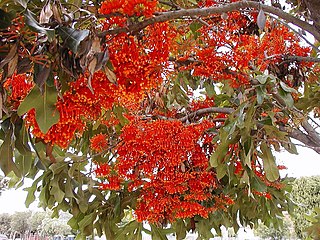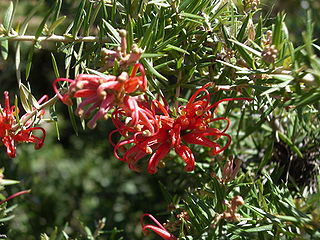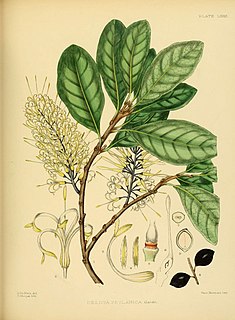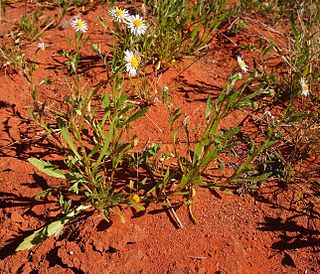
Eucalyptus camaldulensis, commonly known as the river red gum, is a tree that is endemic to Australia. It has smooth white or cream-coloured bark, lance-shaped or curved adult leaves, flower buds in groups of seven or nine, white flowers and hemispherical fruit with the valves extending beyond the rim. A familiar and iconic tree, it is seen along many watercourses across inland Australia, providing shade in the extreme temperatures of central Australia.

Stenocarpus is a genus of about 22 species of flowering plants in the family Proteaceae. They are trees or shrubs with variably-shaped leaves, zygomorphic, bisexual flowers, the floral tube opening on the lower side before separating into four parts, followed by fruit that is usually a narrow oblong or cylindrical follicle.

Austromuellera is a genus of only two known species of medium-sized trees, constituting part of the plant family Proteaceae. They are both endemic to three restricted areas of the wet tropics rainforests of north-eastern Queensland, Australia. The genus was named in 1930 in honour of Ferdinand von Mueller by Cyril T. White. They lie within the tribe Banksieae within the family Proteaceae, their closest relatives the genera Musgravea and Banksia.

Grevillea juniperina, commonly known as juniper- or juniper-leaf grevillea or prickly spider-flower, is a plant of the family Proteaceae native to eastern New South Wales and southeastern Queensland in Australia. Scottish botanist Robert Brown described the species in 1810, and seven subspecies are recognised. One subspecies, G. j. juniperina, is restricted to Western Sydney and environs and is threatened by loss of habitat and housing development.

Helicia is a genus of 110 species of trees and shrubs, constituting part of the plant family Proteaceae. They grow naturally in rainforests throughout tropical South and Southeast Asia, including India, Sri Lanka, Indochina, Peninsular Malaysia to New Guinea and as far south as New South Wales.
Palafoxia arida var. gigantea, with the common name Spanish needles, is a species of flowering plant from the sunflower family (Asteraceae).

The flora of Western Australia comprises 10,551 published native vascular plant species and a further 1,131 unpublished species. They occur within 1,543 genera from 211 families; there are also 1,317 naturalised alien or invasive plant species more commonly known as weeds. There are an estimated 150,000 cryptogam species or nonvascular plants which include lichens, and fungi although only 1,786 species have been published, with 948 algae and 672 lichen the majority.

Laxmannia is a genus of tufted perennial herbs in the family Asparagaceae, subfamily Lomandroideae, that are endemic to Australia.

Vittadinia is a genus of Australian and New Zealand plants in the aster tribe within the daisy family.

Palafoxia arida is a species of flowering plant in the aster family, known by the common names desert palafox and Spanish needle.
Sphalmium is a monotypic genus of flowering plants in the protea family. The only species, Sphalmium racemosum, is a large forest tree. Common names include satin silky oak, mystery oak, Mt Lewis oak, poorman's fishtail oak and buff silky oak.

Ariella Hernandez Arida, also known as Ara Arida, is a Filipino actress, model, and beauty pageant titleholder who was crowned Miss Universe Philippines 2013. She represented the Philippines at the Miss Universe 2013 competition and placed 3rd Runner-Up.
Hollandaea riparia, sometimes named roaring Meg hollandaea, is a species of Australian rainforest tree, in the plant family Proteaceae.

Hakea recurva, commonly known as jarnockmert, is a flowering shrub or small tree in the family Proteaceae and is endemic to an area in the Mid West, northern Wheatbelt and the Goldfields-Esperance regions of Western Australia. It has creams-white to yellow flowers and thick, prickly, curved leaves.
Hakea recurva subsp. recurva is a plant in the family Proteaceae endemic to the south-west of Western Australia.
Hakea recurva subsp. arida is a plant in the family Proteaceae endemic to the south-west of Western Australia.
Olearia arida is upright shrub with spreading branches and clusters of white flowers.
Pultenaea arida is a species of flowering plant in the family Fabaceae and is endemic to the south of Western Australia. It is a low, spindly, spreading shrub with small, flat, hairy leaves and yellow, red or orange flowers.

Vittadinia gracilis, known by the common name woolly New Holland daisy, is a perennial shrub mostly seen in the southern parts of Australia. A member of the Asteraceae, the daisy family. A small plant, 10 to 40 cm high with erect stems. Leaves are flat or folded on the centre, linear to narrow lanceolate or spathulate, 10 to 40 mm long, 2 to 7 mm wide. Stems form annually from a woody base with a coating of dense, fine white hairs, less often seen on the leaves. The specific epithet gracilis is derived from the Latin adjective gracilis.

Vittadinia cuneata, known by the common name fuzzweed, is a is an annual or perennial, herbaceous plant in the daisy family Asteraceae. Stems are rigid and erect with hairs. Widespread in a variety of different habitats in many parts of Australia, particularly the south east. A small woody plant, 10 to 40 cm high. Pale blue to mauve coloured flowers form in most parts of the year. The type specimen was collected in 1817 by Allan Cunningham on the banks of the Lachlan River.













